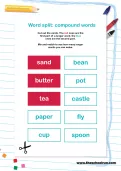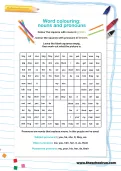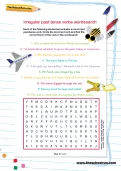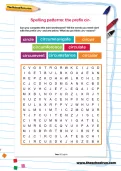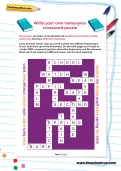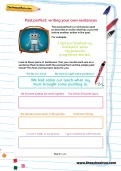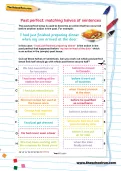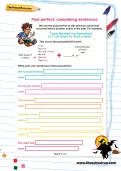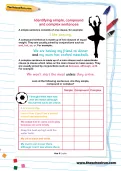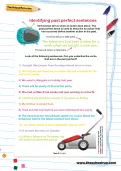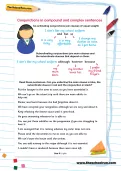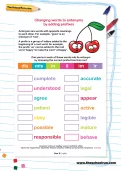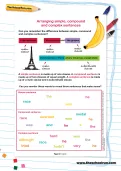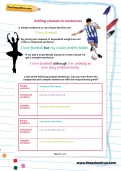Ks2 English worksheets
Free worksheets: Word puzzles, KS2
You’ll need to login or Register first to access these worksheets for free.
Once you’ve tried out our free worksheets, why not explore all our resources (1000s of worksheets, interactive tutorials, learning packs and more) with a 14-day FREE trial subscription.
Word split: compound words
A mix and match puzzle created by teachers, using compound words, to support primary school literacy and demonstrate examples of compound words.
Word colouring: nouns and pronouns
Colour the squares with nouns in green. Colour the squares with pronouns in brown. Leave the blank squares empty, then work out what the picture is.
Irregular past tense verbs wordsearch
A fun and free activity created by an experienced teacher with the aim of teaching KS2 children about irregular past tense verbs. Each of the sentences on the worksheet includes an incorrect past-tense verb. Circle the incorrect verb and then find the correct form of the verb in the wordsearch.
Spelling patterns: the prefix cir-
Can you complete this mini-wordsearch? All the words you need start with the prefix circ- and are below. What do you think circ- means?
Write your own homonyms crossword puzzle
Homonyms are pairs of words that are spelled and pronounced the same way, but have different meanings. Look at these words. Can you work out the two different meanings?
If not, look them up in the dictionary. On the next page you’ll need to create TWO crossword puzzles where the homonyms are the answers. Each word will need two different clues, one for each meaning.
If not, look them up in the dictionary. On the next page you’ll need to create TWO crossword puzzles where the homonyms are the answers. Each word will need two different clues, one for each meaning.
Synonym or antonym?
Synonyms are words that have similar meaning; antonyms are words with opposite meanings. Each of the following sentences contains either a pair of synonyms or a pair of antonyms. Underline each pair of words and then write in the box beside it whether they are synonyms or antonyms.
Subordinating conjunctions
A subordinating conjunction introduces a subordinate clause (a clause that does not make sense on its own). Can you put each of these conjunctions into the gaps in the sentences below?
Simple, compound or complex sentence?
A simple sentence consists of just one clause. A compound sentence consists of two main clauses of equal weight joined by a conjunction. A complex sentence is made up of a main clause and one or more subordinate clauses. Conjunctions such as because, although, until are usually used to link the subordinate clauses to the main clause. Look at these sentences. Can you tick the right-hand column to show whether they are simple, compound or complex?
Simple past or past perfect?
The past perfect is a verb tense that is used to describe an action that has occurred before another action in the past. Cut out these sentences. Which ones include verbs in the past perfect?
Past perfect: writing your own sentences
The past perfect is a verb tense used to describe an action that has occurred before another action in the past. Look at these pairs of sentences. Can you rewrite each one as a sentence that contains both the past perfect and the simple past tense?
Past perfect: matching halves of sentences
The past perfect tense is used to describe an action that has occurred before another action in the past. Cut out these halves of sentences. Can you work out which past perfect tense first half should go with which past tense second half?
Past perfect: completing sentences
We use the past perfect to talk about an action that occurred before another action in the past. Can you write your own sentences in the past perfect?
Pairs of synonyms
Synonyms are words that have similar meaning. For example: ‘overjoyed’ is a synonym for ‘happy’. Cut out the following words. Can you match up the pairs of synonyms?
Matching up main and subordinate clauses
A clause is a group of words that contains a subject and a verb (a doing word). A main clause makes sense on its own. A subordinate clause is dependent on a main clause and does not make sense on its own. Cut out the (blue) main clauses, the (orange) conjunctions and the (purple) subordinate clauses. Match them up to make six sentences that make sense.
Linking clauses with adverbs
Conjunctive adverbs connect one clause to another. They are used to show sequence (eventually, finally,meanwhile), contrast (however, on the other hand) or cause and effect (therefore, subsequently). Can you finish the sentences below by writing a subordinate clause to add to the main clause and adverb given?
Joining sentences with conjunctions
We link main clauses (which make sense on their own) and subordinate clauses (which depend on the main clause) using connectives. Connectives that join clauses can be conjunctions, prepositions and adverbs. Below is a main clause (in blue) followed by conjunctions (in orange). Can you complete each sentence with your own subordinate clauses?
Identifying simple, compound and complex sentences
Can you identify if these sentences are simple, compound or complex?
Identifying past perfect sentences
Verb tenses tell us when an action took place. The past perfect tense is used to describe an action that has occurred before another action in the past. Look at the following sentences. Can you underline the verbs that are in the past perfect?
Identifying main and subordinate clauses
A clause is a part of a sentence that contains a verb. A subordinate clause is one that is dependent on a main clause and does not make sense on its own. We use connectives to join two clauses. Read these sentences. Can you underline the main clause in blue, the subordinate clause in red and the conjunction in green?
Conjunctions in compound and complex sentences
Co-ordinating conjunctions join clauses of equal weight. Subordinating conjunctions join main clauses and the subordinate clauses that depend on them. Read these sentences. Can you underline the main clause in blue, the subordinate clause in red and the conjunction in black?
Co-ordinating conjunctions
We use co-ordinating conjunctions to join two clauses of a sentence that are of ‘equal weight’ (each one could be a stand-alone sentence). Read these sentences and think about which co-ordinating conjunction could go in each gap.
Co-ordinating and subordinating conjunctions
We use co-ordinating conjunctions to join two clauses of a compound sentence that are of equal weight. A subordinating conjunction introduces a subordinate clause (a clause that does not make sense on its own). Read the following sentences and tick whether you think the conjunction used in each is co-ordinating or subordinating
Changing words to antonyms by adding prefixes
Antonyms are words with opposite meanings to each other. For example, ‘good’ is an antonym of ‘bad’. A prefix is a group of letters added to the beginning of a root word; for example,
the prefix ‘un’ can be added to the root word ‘happy’ to make the word ‘unhappy’. Can you turn each of these words into its antonym by choosing the correct prefix from this row?
the prefix ‘un’ can be added to the root word ‘happy’ to make the word ‘unhappy’. Can you turn each of these words into its antonym by choosing the correct prefix from this row?
Arranging simple, compound and complex sentences
A simple sentence is made up of one clause. A compound sentence is made up of two clauses of equal weight. A complex sentence is made up of a main clause and a subordinate clause. Can you reorder these words to reveal three sentences that make sense?
Adding clauses to sentences
Look at the following simple sentences. Can you turn them into compound and complex sentences with the conjunctions given?
